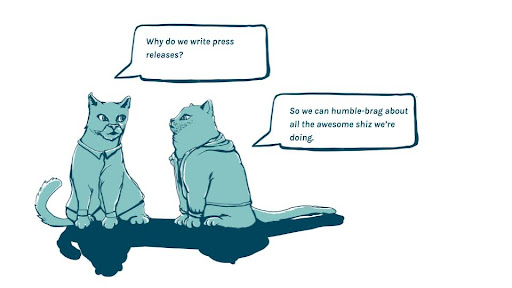In a social media-fueled age, it’s natural to wonder whether press releases retain relevance or are simply yet another fading relic of a bygone era. Sure, they served an important role once—in a time when radio, newspapers, and television drove the public conversation.
But now? Wouldn’t it be easier and more effective to just blast a tweet out to the world?
Sure, it may be easier to just post a company announcement on Instagram. But effectiveness lies in other factors. Namely, you should leverage press releases if the following are true:
- Your goal is to convince the media to publicize your story
- You’re not a major brand or public figure with a devoted audience
- You seek to announce a new product or service
- You wish to establish an ongoing relationship with key media members
That said, a press release’s utility is heavily dependent on the quality of the copywriting. So extra, extra, read all about it. Here’s what you need to know about writing a press release.
Tip 1: Knowing How to Cook an Omelette and Actually Doing it are Two Different Things
Writing a press release isn’t Michelin-star work. At its essence, a press release is just a formal announcement about something new you wish others to talk about. It could be a product launch, a new hire, or a business acquisition.
Whatever it is, the point is to promote your business, archive it for posterity, and drive SEO. Because of this, practically every press release will follow a fairly rote formula (give or take a few formatting decisions):
- Headline
- Subheader
- Intro
- Body
- Conclusion
But just because a medium falls into a certain pattern doesn’t mean it can’t stand out and be unique. As Robert Wynne, Publicist and President of Wynne Communications notes:
“[Press releases] are formulaic, by nature, but so are poetry, tweets, columns and other written communications. Everyone has constraints. Chefs work within an 8-inch pan to create an omelet, and the great ones know how to pick the best ingredients, and mix them to create a savory sensation. Writers can season their sentences within the confines of a release.”
If you’ve ever whipped up a batch of scrambled eggs, then you should know that it’s all too easy to butcher a straightforward recipe if you don’t have the right ingredients. Switch the amounts of salt and sugar in grandma’s famous cookies and they’ll go from irresistible to indigestible in a heartbeat.
The same is true for press releases.
Tip 2: Is It Fit for Print?
There’s no such thing as bad press, right? Wrong. A common pitfall for many businesses is failing to understand what company news is or isn’t worthy of a press release. All too often, it seems as if companies write press releases to simply sing their own praises or stoke the ego of their CEO.

While there is almost always a self-indulgent element to any press release, there’s a fine line that separates a hype-man from a town-crier. But knowing where that demarcation falls can be tricky.
Before you even begin to write the rough draft of a press release, you should reflect on whether or not the event you will be describing is, in fact, noteworthy. Ask yourself:
- Is this something that journalists will find interesting and want to write about?
- Will the story appeal to your target publication?
- Is the story relevant to your target audience?
- Would readers benefit from having this new information?
Journalists want your story to be good since it makes their lives infinitely easier. But they’ll inevitably hold it against you if you continuously send topics that are unremarkable. Therefore, you must respect and value a reporter’s time. Reserve press releases for only the most important events or company milestones.
Tip 3: Grab Them with the Headline
A headline is not only the first thing that a general reader will see if and when a press release gets posted on a news outlet, it’s also the first thing a journalist will see in their email inbox. And for journalists who can receive hundreds of potential press releases each day, yours needs to pop—otherwise, off to spam it goes.
Journalists are the gatekeepers. Fail to pass by them and you’ll be hard pressed to bring the story to the light of day. This means that the header must have some, if not all, of the following elements:
- Clear
- Concise
- Clever
- Captivating
A reader should be able to understand the thrust of the story without ever reading another word. That way, even if they click away, the reader still leaves with the unique selling point having been delivered.
Tip 4: Tell Them Why They Should Care—STAT
The average reader’s attention span is short. You need to capture their attention from the outset and then never let go. Lead with fluff and it’s doomed from the outset. Fill it with jargon and technical mumbo-jumbo and it will be dead on arrival.
The goal is to make it readable and straightforward so it can be directed to the widest possible audience. Cameron Craig, who spent nearly a decade writing press releases for Apple—and had every single press release personally approved by Steve Jobs—had this to say:
“If a ‘mere mortal’ couldn’t understand our language, then we had failed. And failure was not an option...Ideally, you want your content to have a readability score between 80 – 89, and require the education of an 11-year old child. The easier your communications are to understand, the broader the reach.”
Assume that no one will read beyond the initial paragraph. So, in your initial body paragraph you need to answer the 5 W’s (who, what, when, where, why) from the outset. Similar to the headline, this ensures that even if the reader doesn’t complete the entire piece, they’ll at least leave with the key facts.
Tip 5: Write It Like a Reporter Would
To further simplify the lives of the reporters you hope to partner with, it helps to write the press release in the same manner they would. And to do so, the flow of your press release should follow the inverted pyramid of journalism. That means start with the most important information and then continue on with the lesser, more supporting details.
In a press release, this format looks something like:
- The 5 W’s — Who, what, when, where, why
- Supporting details – Typically includes a key quote or two
- Additional facts – More information that supports the purpose of the press release
- Background information – This offers context to the news item or the company itself
If you successfully make a press release look and feel like an actual news article, you’ll become a journalist’s best friend since you’ll have already done most of the leg work for them. Done right, all that will be left for them to do is make some minor edits and tweaks.
By establishing this as a pattern and building up a rapport over time, eventually, journalists will want to hear more and more from you.
For Immediate Release
Copycat Copywriters Captivates Readers with Cat-Created Press Releases
The copywriting agency beloved by humans and felines should be writing your press releases—“fur” real
Brooklyn, New York, October 28th, 2021
The cat’s out of the bag with this one! The scribes at Copycat Copywriters have trained a real-life cat to operate a typewriter and, as suspected, their cold, calculated movements make for red-hot press releases. Once again, Copycat has proven themselves to be the ideal solution for all of your content-related needs, press releases included.
“The press release is a hot button issue these days,” said Adam Biederman, Copycat’s writer extraordinaire. “Thankfully, the household cat has a natural… chilling demeanor.”
Founded in 2017, Copycat has blossomed into a writer’s hub. With 2021 in the rearview mirror and a squadron of talented wordsmiths in their litter, the cats are poised as front-runners in all things content and feline-related, including press releases, blog posts, web copy, catnip, social media, and much, much more.
Client Contact: Sir Bubbles Cutie-Patootie IV
Bubbles&toots@copycatcopywriters.com
555-555-6369
Sources
Forbes. How To Write A Press Release. https://www.forbes.com/sites/robertwynne/2016/06/13/how-to-write-a-press-release/?sh=7eef196f3b93
CBS News. How To Write a Press Release, with Examples. https://www.cbsnews.com/news/how-to-write-a-press-release-with-examples/
Harvard Business Review. What I Learned From 10 Years of Doing PR for Apple. https://hbr.org/2016/07/what-i-learned-from-10-years-of-doing-pr-for-apple

